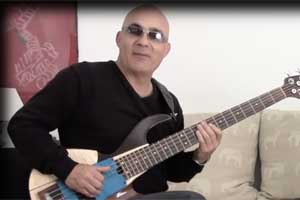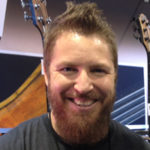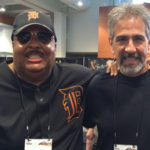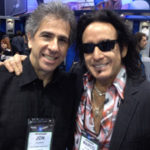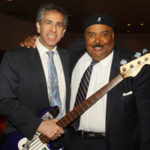European superstar bassist discusses his multi-cultural background, trademark right-hand technique, tours with Gil Evans and John McLaughlin and his own line of basses
Exclusive interview with FBPO’s Jon Liebman
June 28, 2010
Dominque Di Piazza, who resides in France, is of Sicilian origin and was raised by his gypsy stepfather, a heritage that would influence his musicality in later years. Growing up playing both guitar and bass, Dominique began focusing exclusively on the bass in 1979, after hearing a recording of Jaco Pastorius.
A self-taught musician, Dominique developed his own style of playing, culminating in his signature right-hand approach and his unique three- and four-finger techniques. Dominique has performed extensively throughout the world, including major tours with Gil Evans and John McLaughlin. As an educator, he has been teaching at schools of music in France, as well as throughout the world, since 1985.
FBPO: You had a very interesting and unusual upbringing, being of Sicilian origin and raised by a gypsy stepfather. Describe your introduction to music while growing up.
DD: I had always been exposed to gypsy “manouche” music through my stepfather, who was a French gypsy. We lived in a gypsy camp for several years in a suburb of Lyon in France. The music I heard there was a combination of Flamenco, Balkans-style, Django Reinhardt-style and Indian music. My stepfather used to listen to this type of music a lot. He played mandolin and guitar. He was good at repairing musical instruments and knew how to build them, too. In fact he built me my first electric guitar when i was about 15. Growing up in that type of environment made me very open to what is called “World Music” and had a great influence on my musical career, including my approach to the bass and to improvisation.
FBPO: How did you settle on the bass?
DD: I was always very open to different types of music and different cultures. I had a good friend in the mid-’70s who was a Camaroonian singer and guitar player. I used to listen to his group rehearse in the basement and one day he took his guitar and showed me some of the tunes they were playing. After becoming familiar with the music, I knew the bass parts by ear. One day, the bass player couldn’t make it to a rehearsal, so I asked my friend if I could play bass on the tunes I knew. One tune had only three chords, but it was based on a groove, which I found myself able to play. I remember how happy I felt being able to hold down the groove and not lose the time. That was my introduction to the electric bass. I remember it well, too. It was a Fender Musicmaster with black nylon-coated strings going through a Manhattan amp. After hearing me play, the guys asked me to play for a Camaroonian party. I was the only white guy on the stage! It felt good playing the music and seeing the people dancing. With the bass being a pillar in this music, I knew I was laying it down and playing it right.
Back then, I loved playing both the bass and the guitar. I was into the jazz greats like Wes Montgomery, Joe Pass and George Benson. I listened to a lot of beboppers too, like Charlie Parker and, later, Coltrane.
Then I discovered Jaco. The scope and the vision of the instrument he brought was so wide that it made me decide to play the bass exclusively. Right away, I sold my guitar and amp, bought a Fender Jazz bass and started working on the Jaco stuff, just like a lot of guys did at the time. It was 1979 and I was 20.
FBPO: You’re known for your signature right-hand approach to playing the bass. What is it and how did you come up with it?
DD: When I started playing the bass, I already had a lot of musical knowledge and background. At the time, however, in my town, I didn’t have the luxury of being able to see a lot of bass players and, of the ones I did see, everybody used a different technique. I had heard that Jaco was using only two fingers of the right hand. I had been using a pick and was not comfortable using the two-finger technique. Though I knew which kind of musical phrases I wanted to play, I found it very frustrating not being able to play them because of a technical problem. At first, I started experimenting with the thumb and index finger, which I found easier for string crossings, my number-one problem on the bass. I rapidly saw the need for adding the middle finger to my technique so I could execute all kinds of odd note combinations and arpeggios. This technique was probably influenced by watching my African friend, who was playing arpeggios on the guitar with his thumb and index finger, which looked like a Kora technique. The only difference in technique was that I was using the finger flesh instead of my nails.
FBPO: Most bass players, when switching to 5-string, automatically go for the low B. You opted for the high C. How come?
DD: Yes, you are right! I had been playing a four-string for ten years until the early ’90s, when I joined the John Mc Laughlin trio. While we were on tour, John asked me to play some sophisticated chords to “comp” for him on a beautiful ballad. I was having a hard time playing it on a 4-string. I started to work the tune on a Warwick “Steamer” bass and decided to tune the bass with a high C. I figured that way I could adapt very fast because with the E A D G tuning, all the positions are at the same as on a four-string and I wouldn’t get lost like I would if I’d added a sixth string. It takes a while to get used to playing a six-string bass because of the width of the neck and the notes being placed in different spots.
So I started using both four- and five-string basses on stage until one day, when I took the five-string to play a bass solo, I discovered that I could develop more ideas for improvisation. I also liked the way the upper register blended into the mix. It sounded a bit like a guitar. I got caught up with this tuning and couldn’t do without it after that.
FBPO: Playing with Gil Evans must have been an amazing experience! What was it like to perform alongside a true legend?
DD: Yes, playing with Gil Evans was one of my greatest musical memories. He is an important part of jazz history. It was in 1987. We did a European tour and made several recordings. I had been living in Paris for a year and had gotten hired to play in a big band that would play with Gil later. It was such a great experience playing a bass groove while listening to those beautiful horn arrangements, freshly written by the master. Just thinking of it gives me goose bumps!
My friend Laurent Cugny, who is a composer and conductor, was a Gil Evans freak! He helped me a lot when it came to knowing how to play in that band. I don’t read very well and Laurent helped me prepare for all the orchestral bass parts, which he recorded for me and I memorized. He also advanced me some money before the tour so I could buy my Philip Kubicki four-string that sounded as fat as a Fender Jazz!
FBPO: How about John McLaughlin? What was it like to work with him?
DD: I started playing with his trio in 1991. We did several world tours and more than 300 gigs. It was like a dream when I first joined the trio, playing with Trilok Gurtu. The music was very demanding and challenging for me, especially because we played a lot of odd time signatures. But I loved the color of the music. The mix between jazz, Spanish and Indian music was perfect for me, as well as the interaction within the band and all the improv exchanges. I learned a lot in that band. It opened my mind to the importance of the complexity of the rhythm. I am grateful that John hired me and gave me a tremendous musical experience while performing in some of the most beautiful venues with great conditions.
I am also grateful that John would allow me feature solos on stage. It is because of this experience that I can play on stage alone now! When you work with an icon of his stature, your name is forever associated with his.
FBPO: You’ve performed in so many countries throughout the world. Can you comment on the differences in the audiences and their levels of appreciation for the music?
DD: I love to play outside of my country. I love to play in the states, for example. I find the audiences very encouraging and expressive. I like also Japanese audiences.
Of course there are differences in audiences. Some are more reserved, while others are more expressive. The thing that really matters is how you deliver the message. If you are inspired, sincere and believe in what you’re playing, the audience will feel it and react to it.
FBPO: What kind of projects are you involved in now?
DD: Since moving back in Paris last year, I am four times more involved in the music scene than I was while living in the south of France! I play with a new quartet called 4 Essential Violon. We have a lot of dates booked in Europe over the summer and will have a record out in the fall.
I have my own trio with a fabulous guitar player named Nelson Veras and drummer Mahnu Roche, who used to play with Michel Petrucciani. I am also part a trio with Antonio Farao on piano and André Ceccarelli on drums. I’m involved in a lot of other stuff too. This list if pretty long.
I play in a band in Spain with a guitar player named Ximo Tebar, American drummer Donald Edwards and some Cuban musicians living in Spain. I’m in a trio in Ireland with guitarist Mike Nielsen and drummer Paul Wertico. Sometimes I play in Turkey, in Istanbul, with some traditional European musicians. I do a lot of master classes. I love to teach and share my experience with young people.
I’m also looking forward to continuing my collaborations with luthier Mike Sabre, who built a Dominique Di Piazza signature bass, as well as a very unique fretless bridge we designed. We’re also working together on marketing my method for right-hand picking technique and the “Pocket Picker,” a tool for exercising the right hand.
FBPO: What do you see as the next step in your career?
DD: Looking ahead ten years, I can see playing around the world, getting inspired and inspiring others. I’d like to show people that there is a lot to say with this beautiful instrument, as we discover more and more of the essence of musical expression.
FBPO: What sorts of things do you like to do that aren’t necessarily musically oriented?
DD: I like being in nature, cyling. I also enjoy talking about theology and philosophy. I like being at home with my family.
I am also a Tintin freak. Tintin is a cartoon, not widely known in America yet. I’m a collector. I heard that Steven Spielberg will be releasing a movie next year called The Adventures of Tintin: Secret of the Unicorn.
